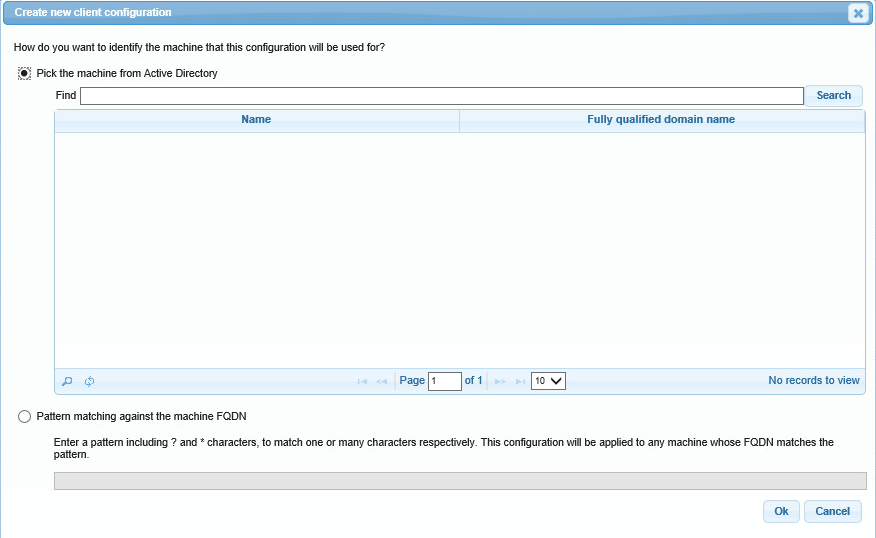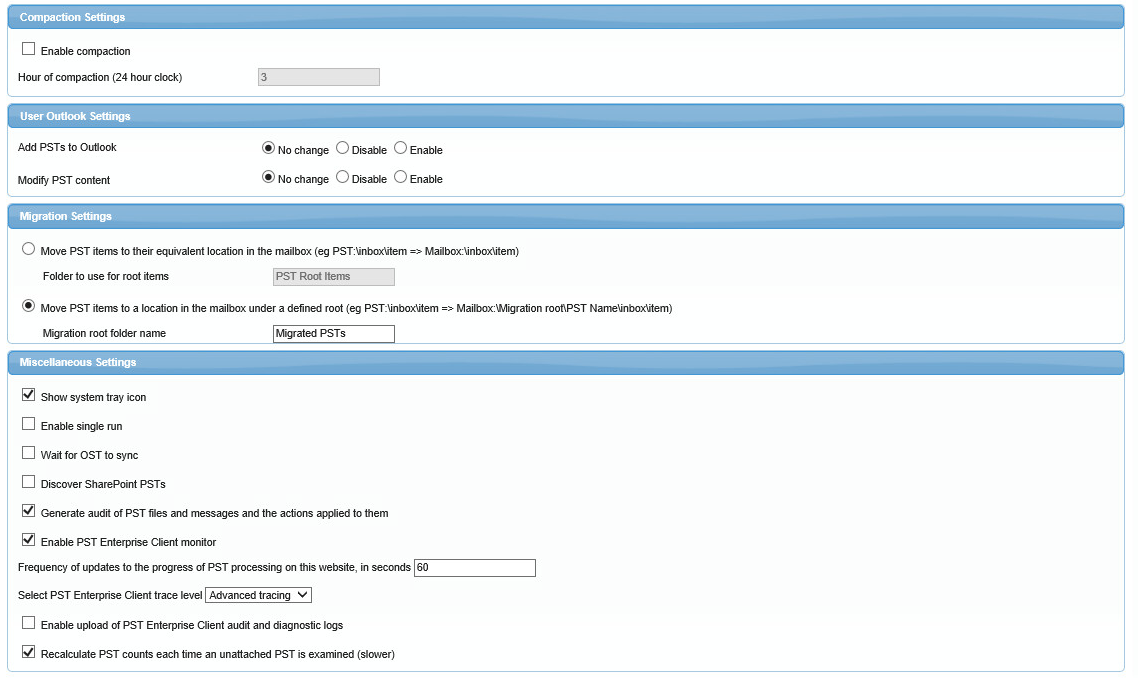This article refers to the Barracuda PST Enterprise version 5.1 or higher.
Use the Client Configuration tab to specify default and client-specific settings. Default setting are applied to all clients that do not have specific configuration settings:
Client Name
Use this section to add or remove client-specific settings. To add client-specific settings, click the Add ( ![]() ) icon to the right of Client Name, and enter or search for the desired client system. To remove a client system, click the Remove (
) icon to the right of Client Name, and enter or search for the desired client system. To remove a client system, click the Remove (![]() ) icon next to the machine's settings.
) icon next to the machine's settings.
An individual machine can be selected from Active Directory, or alternatively a group of machines can be selected by pattern matching the client machine's fully qualified domain name (FQDN). For example:
- if you want to match all the client machines in the domain uk.barracuda.local but not us.barracuda.local, enter: *.uk.barracuda.local
- if you want to match all the client machines which are prefixed UK, but not US, enter: UK*
Time Settings
These settings apply to both default and client-specific settings.
- Stall factor – Specify the delay interval between individual message processing. Use this feature to provide throttling to prevent overloading of network bandwidth or Exchange processing when migrating messages.
- Startup delay – Specify the interval after Barracuda PST Enterprise initially starts but before it begins processing PST files. This allows time for client machines to reach a fully running state in case the application is started from a login script.
- Restart delay – Specify the interval time between processing runs; a randomization factor of up to ±50% of this value is applied to the given value to ensure that multiple instances of the PST Enterprise Client do not flood the network by starting simultaneously.
Start and Stop Settings
These settings apply to both default and client-specific settings.
When Control PST Enterprise Client operating times is set to On, set PST file processing to a specific time period.
Where to look for PSTs
These settings apply to both default and client-specific settings.
Specify the type of processing the PST Enterprise Client is to perform:
- Outlook Profile – When set to On, PST files configured in the Outlook profile are processed while Outlook is running. Turn on Exclude PSTs discovered connected to Outlook whose file path contains the following to exclude PST files in a specific path.
- File system – When set to On, the application searches the file system for PST files and then processes them, starting Microsoft Outlook as necessary. You can select to search for PST files in All Drives, or select Selected paths and enter the path in the Paths to search field. The drive options are fixed (locally connected), removeable (e.g., optical drives), network (drive letter mapped to a network location), and read-only media (CDs and DVDs).
PSTs can be excluded if they have specified text in their path. You can specify more than one block of text by separating them with a semicolon (;). Any path can include environment variables enclosed in percent (%) characters, for example, enter %HOMEPATH% to use the home path of the logged in user.
When exclusions are considered, mapped drives are considered as their UNC counterpart. That is, if you add \\myserver\Users as an exclusion and a user has mapped that path to a local drive letter, the local drive is still excluded. This also applies to any overlapping path within the UNC or mapped drive.
Compaction Settings
The PST Enterprise Client can trigger compaction of attached PST files using Outlook’s Compact Now technology which reduces the PST file size by eliminating unused space. When enabled, you must specify the time you want compaction to take place. Note that Outlook must be running at this time for compaction to occur.
User Outlook Settings
These settings allow you to control users’ ability to add new data to existing PST files or to create new PST files. This is useful, for example, if you want to prevent any future PSTs from being added to Outlook or prevent existing PSTs from being modified.
Migration Settings
During migration, PST Enterprise can move items to user mailboxes. There are two different ways in which items can be migrated:
- Move PST Items to their equivalent location in the mailbox – Ensures that the folder hierarchy within the PST is preserved when the items are migrated to the target mailbox. For example, items located in the PST folder Inbox\MyFolder are migrated to the equivalent folder location in the Mailbox Inbox\MyFolder. PST Enterprise creates the target folder if it does not exist.
- Folder to use for root items – PSTs can contain items located in the root of the PST. However, there is not an equivalent location within a user mailbox. Configure this option to allow PST Enterprise to create this folder in the user mailbox and store items from the PST root in this location.
- Move PST items to a location in the mailbox under a defined root – Allows you to place PST items under a common folder within a user mailbox. For example, if you set the Migration root folder name to Migrated PSTs, any items located in Inbox\MyFolder in your PST called MyPST are migrated to \Migrated PSTs\MyPST\Inbox\MyFolder. Note that the Migrated PSTs are created in the root of your mailbox, at the same level as your Inbox. Additionally, the folder hierarchy contains a sub-folder using the name of the PST from which the items came, in the previous example, MyPST.
Miscellaneous Settings
- Show user interface – When enabled, the PST Enterprise Client displays a tool tray icon that allows you to access the UI to monitor operation. When disabled, users cannot access the application.
- Enable single run – Under normal operation the PST Enterprise Client processes repeatedly throughout the period defined by the start and stop settings with a frequency determined by the restart delay. When enabled, the application only processes PST files once when started and then exits.
- Wait for OST to sync – When enabled, when messages are migrated from the PST to the Outlook cached mode version of the mailbox, the PST Enterprise Client waits for the messages to be moved by Outlook into the real mailbox before continuing with the next PST file.
- Discover SharePoint PSTs – When enabled, PST files created by SharePoint (usually containing calendar information) are discovered in addition to standard PST files (usually they are excluded). SharePoint and Internet calendar-type PST files are treated as any other PST file and processed according to the assigned policy. To determine if a PST file is a SharePoint PST, the PST Enterprise Client examines Calendar folders contained in the PST. If it finds any items in those folders that have a MAPI property named STS_Id, the PST is considered a SharePoint PST.
- Generate audit of PST files and messages and the actions applied to them – When enabled, when the PST Enterprise Client makes any changes to messages or PST files, for example, move or delete, it writes a record to an audit file kept on the machine where the PST Enterprise Client was running at the time.
- Enable PST Enterprise Client monitor – When enabled, the PST Enterprise Client Monitor runs on every machine on which PST Enterprise Client runs and ensures the PST Enterprise Client is always running. If it stops for any reason, it is restarted.
- Frequency of updates to the progress of PST processing on this website, in seconds – Indicates how often a PST Enterprise Client should call in to the service to update it with the progress of PST file processing. The default is 60 seconds, which is suitable for evaluation purposes, but it is recommended that you increase this to 10-15 minutes for production environments. This limits the volume of network traffic generated by the client updates, which can be significant on large scale deployments of thousands of client machines.
- Select PST Enterprise Client trace level – Sets the diagnostic trace level for PST Enterprise Client, which can usually be left at No tracing unless otherwise advised by Support.
Enable upload of PST Enterprise Client logs – When enabled, audit and diagnostic tracing from PST Enterprise Client is uploaded into the ClientLogs subdirectory of the installation directory, which is shared as PSTEnterpriseClientLogs. The logs are arranged in subdirectories by machine name and user name.
- Recalculate PST counts each time an unattached PST is examined (slower) – When enabled, the number of messages and the number of folders with an unattached PST file is only counted once when the PST file is first discovered. On subsequent runs, the message and folder counts are not performed and the policy action is immediately applied to the PST file. This can improve performance as it takes time to perform the PST counts, but this can lead to inaccurate reporting of the message and folder counts reported if the PST file is subsequently altered after its initial discovery. If you have restricted users' ability to modify PST data, then it is not anticipated for this data to change during processing. The setting only affects PST files which are not open in Outlook. PST files which are coupled and open in Outlook always have their message and folder counts calculated.


